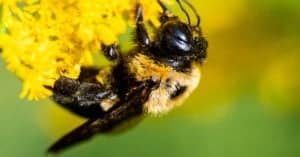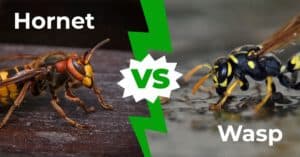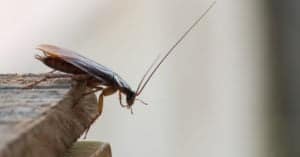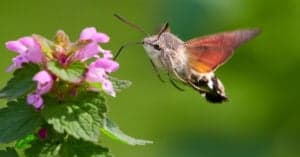Cicadas vs Locusts: What’s The Difference?
Key Points:
- While many people think cicadas and locusts are the same insect, a cicada is more similar to an aphid, while a locust is a type of short-horned grasshopper. Locusts travel in swarms and can destroy crops, while cicadas are much less destructive when they feed.
- Cicadas and locusts are similar in that they both can fly, they are loud in groups, and neither is threatening to humans.
- The cicada nymph can live up to 17 years underground after hatching, while the total lifespan of a locust is typically 3-5 months long.
With all the news stories about Cicadas and how Brood X is hatching in 2021, a lot of you probably have black, buzzing swarms of bugs on the brain! If you’re worried about Cicadas being like the plagues of Locust swarms you may have seen in movies, destroying crops and causing famine, don’t be!
Are Cicadas and Locusts the Same Thing?
Though they do share some similarities, and the names have been improperly used interchangeably almost since Cicadas were first discovered in North America, Cicadas and Locusts are not the same!
If one looks at Cicadas vs Locusts: what’s the difference though? In simplified terms, a Cicada is more similar to an aphid, while a Locust is a type of short-horned grasshopper. If you’re looking for more specifics, don’t worry! We’re going to list many of the similarities and differences below, including what each insect’s basic life cycle is and what sort of sound each one makes.
The biggest difference between Cicadas and Locusts is probably that, while they do emerge in very large numbers when they hatch, Cicadas do not swarm as Locusts do. Cicadas also do not decimate and consume crops in the same way as Locusts. Locusts and Cicadas are both herbivores, but Cicadas are far less destructive when they feed. In fact, a lot of the damage Cicadas cause to plants comes from their egg-laying process, as opposed to their feeding habits. Locusts are both longer and thinner than Cicadas, with the long back legs common to all grasshoppers.
Cicadas have very small legs. Periodical Cicadas, the kind that only emerges from underground every 13-17 years, are only found in North America, where swarming Locusts have not been found since the Rocky Mountain Locust went extinct in 1902 and the High Plains Locust nearly so after a plague in 1930.
There are some similarities between these two insects. Both Cicadas and Locusts have wings, though Locusts tend to fly much greater distances. Both of these creatures eat plants and lay eggs. They are both very loud and usually appear in large groups. Neither Cicadas nor Locusts are aggressive toward humans, though it might feel that way if a large group of them in flying and you get in their way!
Let’s break down a few more of their differences and similarities in the following list.
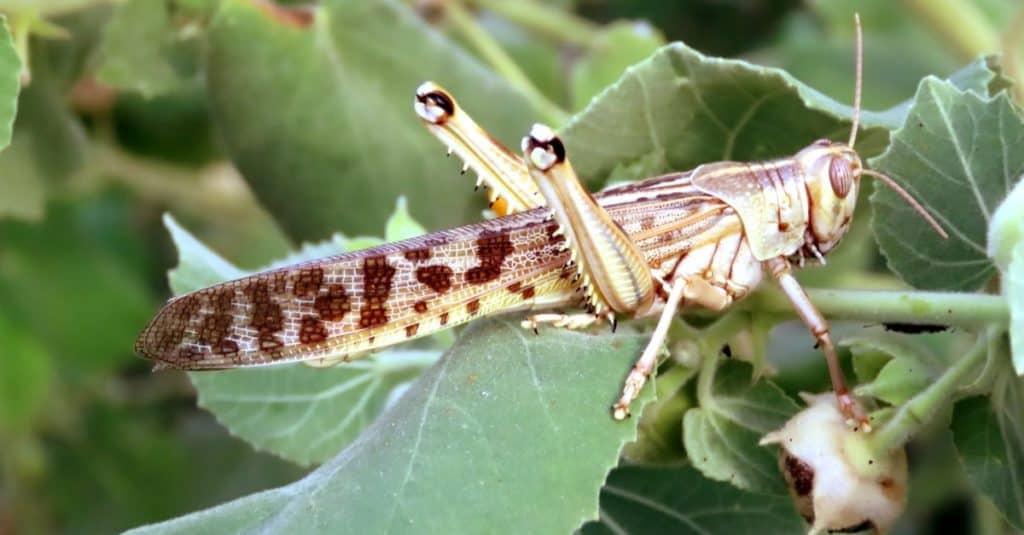
Order
Cicada
Cicadas are a type of Hemiptera or “True Bug.” Some think they are related to crickets, but really they are not. Though they are much larger, Cicadas are similar to aphids, which are also in the Hemiptera order.
Locust
Locusts belong to the order Orthoptera. This order divides into two suborders, with Locusts and grasshoppers on one side and crickets on the other.
Family
Cicada
Cicadas are in the family Cicadidae, which covers any bug that makes a sound, has prominent eyes, two membranous pairs of wings, and both compound and simple eyes.
Locust
Locusts are Acrididae. That family designation refers to any short-horned grasshoppers which migrate and swarm in great numbers.
Size
Cicada
Cicadas are typically about two inches long and half an inch across.
Locust
Locusts can reach up to four inches long, but some are less than half an inch in length!
Diet
Cicada
Cicadas drink the liquid from the inside of the stems, roots and branches of plants.
Locust
Locusts eat the leaves and any of the softer segments of plants, which is why they are so destructive to crops when they swarm in plagues. They leave very little behind.
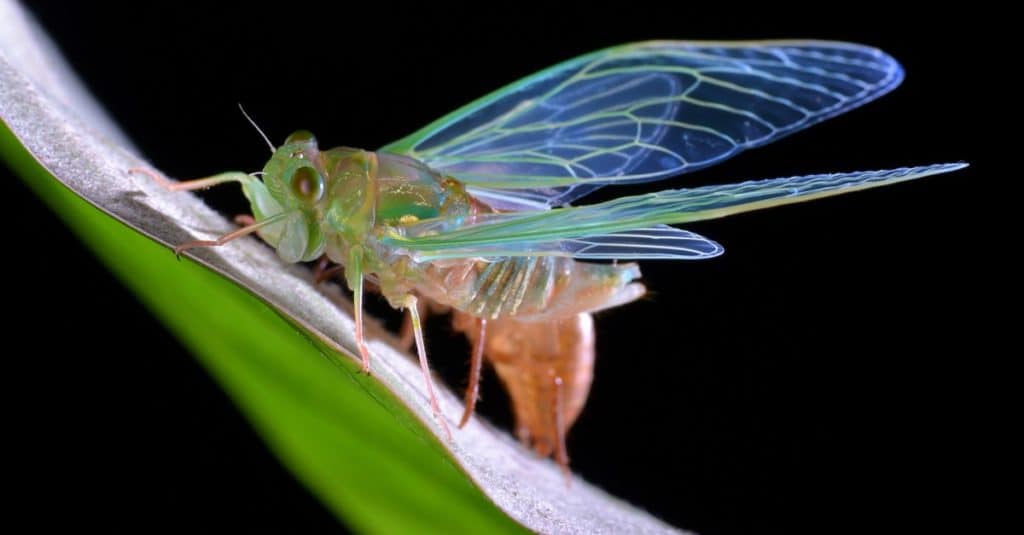
SIMON SHIM/Shutterstock.com
Lifespan
Cicada
The Cicada life cycle is very interesting. They lay their eggs on plants. When the eggs hatch, they become nymphs, which drop down to burrow into the ground where they live for most of their life. While underground, a Cicada nymph can live up to 17 years! Once they emerge, as Brood X will in 2021, they shed their outer shell and, once they lay more eggs, will die after about six weeks after emergence.
Locust
Locusts have a much more mundane life cycle. They lay their eggs on the ground. Once they hatch, Locusts typically live between three to five months, but during that time they may lay as many as 1000 eggs!
Collective Name
Cicada
A group of Cicadas is known as a brood. In the United States, these broods have been given letter names according to their life cycle and which years they will hatch, such as Brood X, hatching in 2021.
Locust
A large swarm of Locusts is called a plague.
Distinguishing Features
Cicada
Periodical Cicadas are most commonly black with bright red eyes, and the annual species are a very beautiful blue-green and black striped pattern. They are similar in size to an average human thumb. Their wings are a transparent yellow-orange color and extend beyond the end of their abdomens, protecting them from water and also bacteria. The males use a pair of organs known as tymbals to make a very loud buzzing vibration that resonates through their mostly hollow bodies. The sound Cicadas make can reach up to 100 decibels!
Locust
Locusts are very similar in appearance to grasshoppers. They tend to be green before they go into their swarming phase, at which point their heads shrink and they change to brown and black or black with orange spots. They have two long, pointy antennae on the top of their heads and very long back legs which remain bent in half when they are at rest. They are much quieter insects, who make their sounds but rubbing two of their body parts together to create a buzzing or sometimes a snapping sound.
Which is the Most Feared by Humans?
While locusts and cicadas pose no physical threat to humans, one out-ranks the other as a threat to human crops. The appetite of a locust is voracious, and a plague of locusts about 1/3 of a square mile in size can consume food that would feed up to 35,000 people! The largest locust outbreak ever recorded took place between 2003 and 2005 in Africa, costing $2.5 billion in damaged crops. Because locust outbreaks are unpredictable, and the space of time between outbreaks can be years or decades, many countries don’t properly prepare to fight the plagues when they do occur, which can lead to complete devastation.
Whatever their differences, both Cicadas and Locusts are fascinating creatures!
Cicada Brood X News & Information
Brood X is currently (spring 2021) emerging on the east coast of the United States. More information and coverage can be found here!
- Cicadas in New York: What’s Happening Now?
- Cicadas in Pennsylvania: What’s Happening Now?
- Cicadas in Virginia: What’s Happening Now?
- Cicadas in Tennessee: What’s Happening Now?
- Cicadas in Washington, DC: What’s Happening Now?
- Cicadas in Maryland: What’s Happening Now?
- Here’s What 1.5 Million Cicadas Looks Like
- Will Cicadas Cause More Snakes? Copperheads?
- Can Dogs Eat Cicadas?
- Will Cicadas Eat My Tomato Plants?
- Cicada Brood X 2021: What is it and should you be concerned?
- Why Do Cicadas Only Come Out Every 17 Years?
- Cicadas vs Locusts: What’s The Difference?
Up Next…
- Ladybug vs Japanese Beetle: What are the Differences? How does the ladybug compare to the Japanese beetle? Learn more in this fascinating read.
- Cicadas Lifespan: How Long Do Cicadas Live? Find out more about the amazing life span of the cicada in this article.
- Are Insects Animals? Ever wondered if insects are technically classified as animals or not? Let’s dive into the topic and answer that question.
More from A-Z Animals
Key Points:
- While many people think cicadas and locusts are the same insect, a cicada is more similar to an aphid, while a locust is a type of short-horned grasshopper. Locusts travel in swarms and can destroy crops, while cicadas are much less destructive when they feed.
- Cicadas and locusts are similar in that they both can fly, they are loud in groups, and neither is threatening to humans.
- The cicada nymph can live up to 17 years underground after hatching, while the total lifespan of a locust is typically 3-5 months long.
With all the news stories about Cicadas and how Brood X is hatching in 2021, a lot of you probably have black, buzzing swarms of bugs on the brain! If you’re worried about Cicadas being like the plagues of Locust swarms you may have seen in movies, destroying crops and causing famine, don’t be!
Are Cicadas and Locusts the Same Thing?
Though they do share some similarities, and the names have been improperly used interchangeably almost since Cicadas were first discovered in North America, Cicadas and Locusts are not the same!
If one looks at Cicadas vs Locusts: what’s the difference though? In simplified terms, a Cicada is more similar to an aphid, while a Locust is a type of short-horned grasshopper. If you’re looking for more specifics, don’t worry! We’re going to list many of the similarities and differences below, including what each insect’s basic life cycle is and what sort of sound each one makes.
The biggest difference between Cicadas and Locusts is probably that, while they do emerge in very large numbers when they hatch, Cicadas do not swarm as Locusts do. Cicadas also do not decimate and consume crops in the same way as Locusts. Locusts and Cicadas are both herbivores, but Cicadas are far less destructive when they feed. In fact, a lot of the damage Cicadas cause to plants comes from their egg-laying process, as opposed to their feeding habits. Locusts are both longer and thinner than Cicadas, with the long back legs common to all grasshoppers.
Cicadas have very small legs. Periodical Cicadas, the kind that only emerges from underground every 13-17 years, are only found in North America, where swarming Locusts have not been found since the Rocky Mountain Locust went extinct in 1902 and the High Plains Locust nearly so after a plague in 1930.
There are some similarities between these two insects. Both Cicadas and Locusts have wings, though Locusts tend to fly much greater distances. Both of these creatures eat plants and lay eggs. They are both very loud and usually appear in large groups. Neither Cicadas nor Locusts are aggressive toward humans, though it might feel that way if a large group of them in flying and you get in their way!
Let’s break down a few more of their differences and similarities in the following list.

Order
Cicada
Cicadas are a type of Hemiptera or “True Bug.” Some think they are related to crickets, but really they are not. Though they are much larger, Cicadas are similar to aphids, which are also in the Hemiptera order.
Locust
Locusts belong to the order Orthoptera. This order divides into two suborders, with Locusts and grasshoppers on one side and crickets on the other.
Family
Cicada
Cicadas are in the family Cicadidae, which covers any bug that makes a sound, has prominent eyes, two membranous pairs of wings, and both compound and simple eyes.
Locust
Locusts are Acrididae. That family designation refers to any short-horned grasshoppers which migrate and swarm in great numbers.
Size
Cicada
Cicadas are typically about two inches long and half an inch across.
Locust
Locusts can reach up to four inches long, but some are less than half an inch in length!
Diet
Cicada
Cicadas drink the liquid from the inside of the stems, roots and branches of plants.
Locust
Locusts eat the leaves and any of the softer segments of plants, which is why they are so destructive to crops when they swarm in plagues. They leave very little behind.

SIMON SHIM/Shutterstock.com
Lifespan
Cicada
The Cicada life cycle is very interesting. They lay their eggs on plants. When the eggs hatch, they become nymphs, which drop down to burrow into the ground where they live for most of their life. While underground, a Cicada nymph can live up to 17 years! Once they emerge, as Brood X will in 2021, they shed their outer shell and, once they lay more eggs, will die after about six weeks after emergence.
Locust
Locusts have a much more mundane life cycle. They lay their eggs on the ground. Once they hatch, Locusts typically live between three to five months, but during that time they may lay as many as 1000 eggs!
Collective Name
Cicada
A group of Cicadas is known as a brood. In the United States, these broods have been given letter names according to their life cycle and which years they will hatch, such as Brood X, hatching in 2021.
Locust
A large swarm of Locusts is called a plague.
Distinguishing Features
Cicada
Periodical Cicadas are most commonly black with bright red eyes, and the annual species are a very beautiful blue-green and black striped pattern. They are similar in size to an average human thumb. Their wings are a transparent yellow-orange color and extend beyond the end of their abdomens, protecting them from water and also bacteria. The males use a pair of organs known as tymbals to make a very loud buzzing vibration that resonates through their mostly hollow bodies. The sound Cicadas make can reach up to 100 decibels!
Locust
Locusts are very similar in appearance to grasshoppers. They tend to be green before they go into their swarming phase, at which point their heads shrink and they change to brown and black or black with orange spots. They have two long, pointy antennae on the top of their heads and very long back legs which remain bent in half when they are at rest. They are much quieter insects, who make their sounds but rubbing two of their body parts together to create a buzzing or sometimes a snapping sound.
Which is the Most Feared by Humans?
While locusts and cicadas pose no physical threat to humans, one out-ranks the other as a threat to human crops. The appetite of a locust is voracious, and a plague of locusts about 1/3 of a square mile in size can consume food that would feed up to 35,000 people! The largest locust outbreak ever recorded took place between 2003 and 2005 in Africa, costing $2.5 billion in damaged crops. Because locust outbreaks are unpredictable, and the space of time between outbreaks can be years or decades, many countries don’t properly prepare to fight the plagues when they do occur, which can lead to complete devastation.
Whatever their differences, both Cicadas and Locusts are fascinating creatures!
Cicada Brood X News & Information
Brood X is currently (spring 2021) emerging on the east coast of the United States. More information and coverage can be found here!
- Cicadas in New York: What’s Happening Now?
- Cicadas in Pennsylvania: What’s Happening Now?
- Cicadas in Virginia: What’s Happening Now?
- Cicadas in Tennessee: What’s Happening Now?
- Cicadas in Washington, DC: What’s Happening Now?
- Cicadas in Maryland: What’s Happening Now?
- Here’s What 1.5 Million Cicadas Looks Like
- Will Cicadas Cause More Snakes? Copperheads?
- Can Dogs Eat Cicadas?
- Will Cicadas Eat My Tomato Plants?
- Cicada Brood X 2021: What is it and should you be concerned?
- Why Do Cicadas Only Come Out Every 17 Years?
- Cicadas vs Locusts: What’s The Difference?
Up Next…
- Ladybug vs Japanese Beetle: What are the Differences? How does the ladybug compare to the Japanese beetle? Learn more in this fascinating read.
- Cicadas Lifespan: How Long Do Cicadas Live? Find out more about the amazing life span of the cicada in this article.
- Are Insects Animals? Ever wondered if insects are technically classified as animals or not? Let’s dive into the topic and answer that question.

